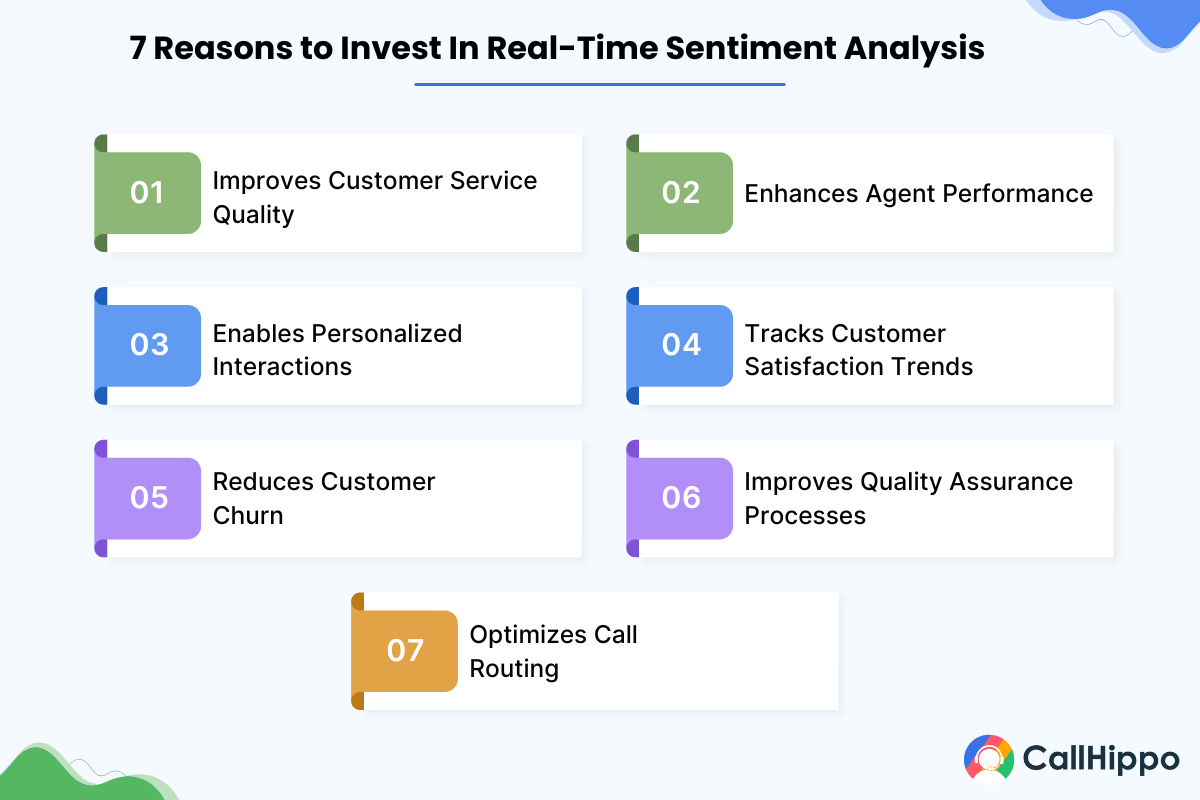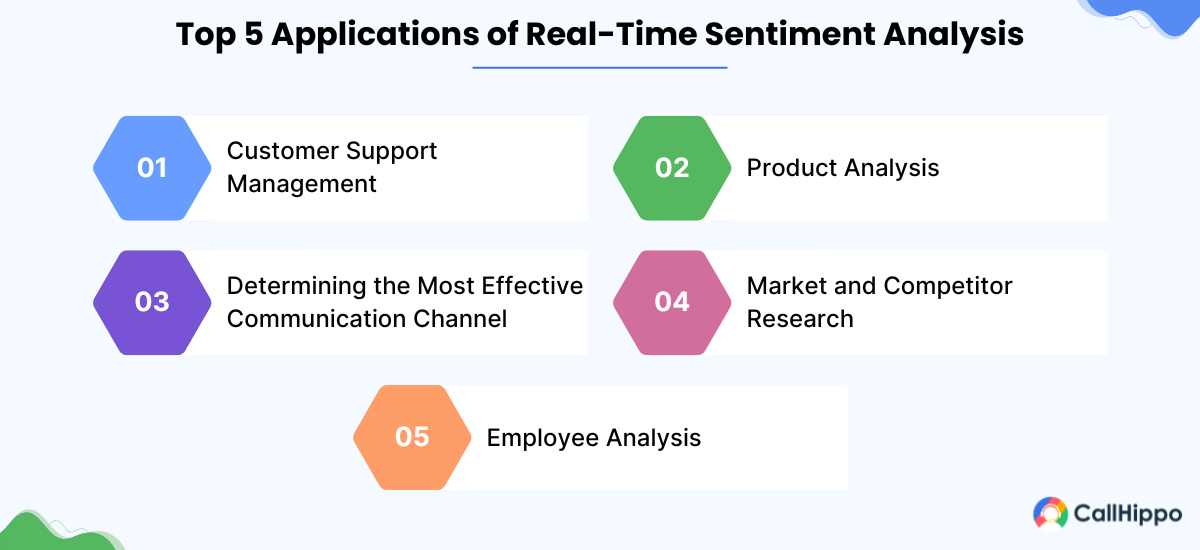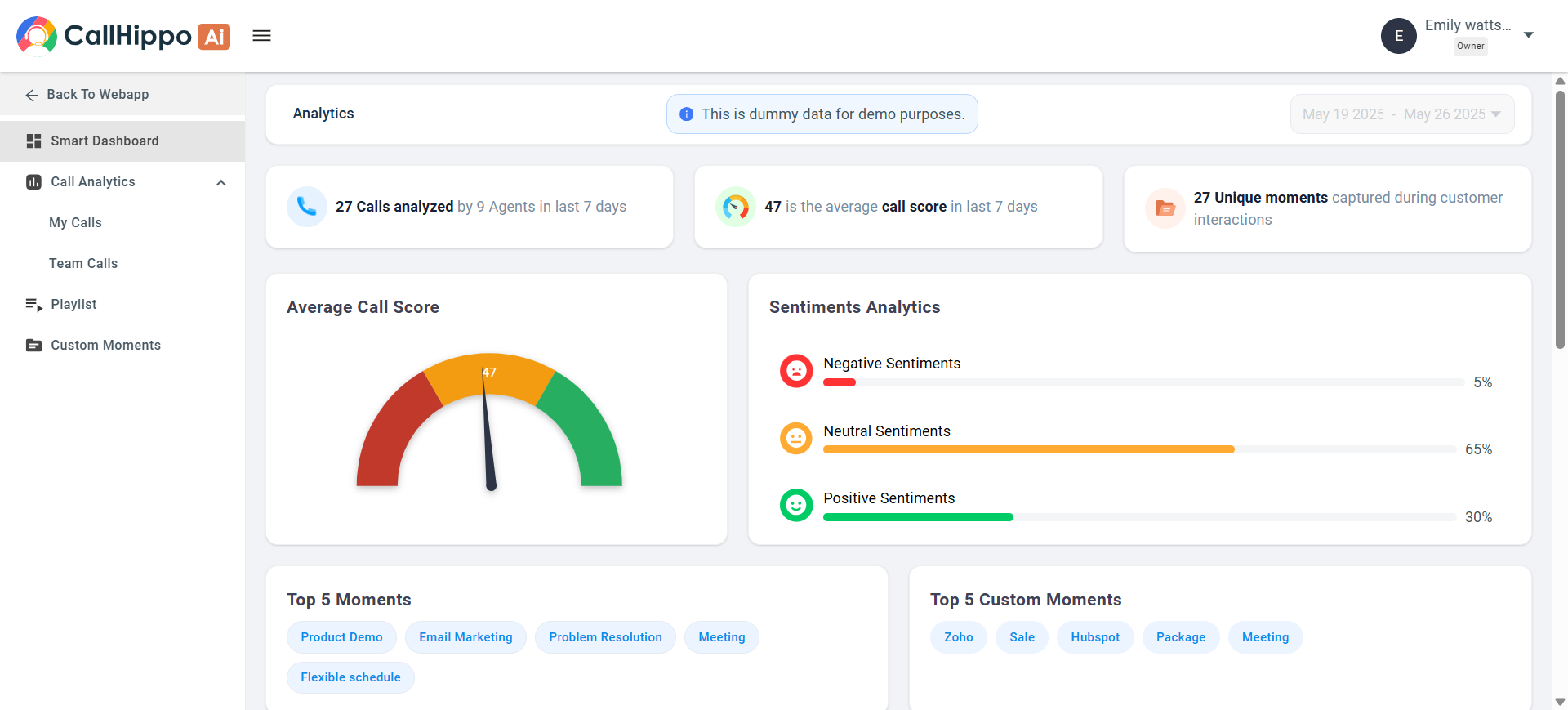Real-time sentiment analysis allows companies to rapidly grasp customer emotions during interactions. It looks at what customers say or write and figures out if they’re happy, upset, or neutral. This happens in real-time, which allows companies to respond right away. As markets become more competitive, real-time sentiment analysis becomes even more important for keeping customers satisfied and loyal.
But what is sentiment analysis, and why is it important? We’ll discuss this and we’ll also understand how you can use it to your advantage.
When implementing real-time sentiment analysis, start with a clear goal and a specific use case. Begin by focusing on one aspect, such as improving customer satisfaction or enhancing agent performance. This targeted approach allows you to measure the impact effectively and refine your strategy before expanding to other areas.
What is Sentiment Analysis?
Sentiment analysis, also known as opinion mining, is a technique that helps businesses identify and categorize the words spoken or written by customers based on their emotions. It leverages computational linguistics and text analysis to identify the emotional tone behind the words. It then classifies the sentiment as positive, negative, or neutral. The process uses various methodologies, including lexicon-based approaches, which use predefined lists of words associated with specific sentiments.
The Importance of Real-Time Sentiment Analysis
Real-time sentiment analysis helps understand customer emotions and improve service quality instantly. Let’s understand in detail.

1- Improves Customer Service Quality
Real-time sentiment analysis helps call center agents detect customer emotions quickly during interactions. This immediate insight allows agents to adjust their approach when dealing with upset customers. For example, if a customer’s tone indicates frustration, the agent can switch to a more empathetic communication style. This adaptability leads to more effective problem-solving and higher customer satisfaction.
2- Enhances Agent Performance
Supervisors can use sentiment analysis data to monitor trends across calls and provide timely coaching to agents. The system can flag calls with extremely negative sentiments, allowing managers to intervene in critical situations. This real-time feedback mechanism helps agents improve their skills continuously and handle difficult conversations more effectively.
3- Enables Personalized Interactions
Automated sentiment analysis allows agents to personalize their responses depending on how the customer is feeling. This personalization creates more empathetic and satisfying conversations. For instance, if a customer expresses confusion, the agent can slow down their explanation and use simpler terms.
4- Tracks Customer Satisfaction Trends
Call centers can measure overall satisfaction trends by analyzing sentiment across all calls. This offers a thorough understanding of customer views as they evolve. Managers can utilize these learnings to pinpoint aspects of their service that need improvement and leverage data to make choices that boost customer satisfaction.
5- Reduces Customer Churn
Identifying and addressing negative sentiment early on can prevent customer loss. When the system detects a highly dissatisfied customer, it can alert supervisors to intervene or flag the account for follow-up. This way, you can make customers happy before they decide to leave.
6- Optimizes Call Routing
Sentiment analysis can help direct calls with negative sentiments to more experienced agents or specialized teams. This ensures that complex or sensitive issues are handled by the most qualified staff. For example, a call expressing high frustration about a technical issue can be routed to a senior technical support agent to increase the chances of a satisfactory resolution.
7- Improves Quality Assurance Processes
Sentiment analysis algorithms enhance call quality evaluation with objective insights. Quality assurance teams gain a more comprehensive view of customer interactions by incorporating emotional data alongside traditional metrics. The system reveals patterns in customer emotions throughout calls, highlighting areas where agents excel and where they struggle.
Applications of Real-Time Sentiment Analysis
There are several applications of real-time sentiment analysis, including customer support management, product analysis, identifying the best channel, and employee analysis. Let’s understand this in detail.

1- Customer Support Management
A real-time sentiment analysis system interprets the meaning, emotion, and tone of each customer interaction. Call centers can then prioritize urgent cases and tailor their responses accordingly. In situations where a customer displays high levels of frustration, the system can immediately escalate the case to a senior agent for swift resolution.
2- Product Analysis
Call centers use automated sentiment analysis to understand how customers react to new products or features. By analyzing customer feedback during calls, companies can identify which aspects of their products customers like or dislike. This empowers call centers to make data-backed decisions about product improvements. For instance, if many customers express confusion about a particular feature, the company can focus on improving its user-friendliness.
3- Determining the Most Effective Communication Channel
Sentiment analysis helps call centers identify which communication channels work best for their target audience. By comparing sentiment across different channels (phone, chat, email), companies can optimize their customer service strategy. This analysis might reveal, for example, that customers prefer to chat for quick queries but phone calls for complex issues.
4- Market and Competitor Research
Sentiment analysis equips businesses with insights into market trends and competitor performance. Companies gain a clearer understanding of their market position through analysis of customer opinions about rival products or services. This highlights potential areas for improvement in their offerings.
5- Employee Analysis
Sentiment analysis tools evaluate employee performance and emotional states during customer interactions in call centers. Call center managers gain objective insights into how agents handle different situations, especially challenging ones. It also identifies agents who consistently maintain a positive tone when dealing with upset customers. This can help managers recognize top performers, pinpoint areas for improvement in training programs, and ensure consistent quality of customer service across the team.
Top Tools for Analyzing Customer Sentiment in Real-Time
Several tools help you analyze customer sentiment, including CallHippo, JustCall, Repustate, and MonkeyLearn. There are even more tools available in the market. Let’s look at them.
1- CallHippo AI

CallHippo AI is an advanced call center solution that integrates artificial intelligence to enhance business conversations and sales processes. It offers real-time sentiment analysis to evaluate caller emotions, which helps agents personalize their approach. Furthermore, CallHippo’s topic extraction feature identifies recurring themes in conversations and uncovers customer preferences and trends.
2- JustCall AI
JustCall AI combines call center functionality with advanced sentiment analysis. It transcribes calls in real-time and analyzes the text to understand emotions. The system identifies key moments in conversations, allowing supervisors to intervene if necessary. JustCall AI offers features like sentiment scoring, topic detection, and automated call summaries. These insights help businesses improve customer service strategies and agent performance.
3- Repustate
Repustate is a versatile sentiment analysis tool that processes various data types, including text, video, and audio. Repustate offers features like entity extraction, theme detection, and sentiment visualization. The tool helps businesses understand customer opinions about products, services, and brand image. It’s particularly useful for market research and brand monitoring.
4- MonkeyLearn
MonkeyLearn is a machine-learning platform that specializes in real-time sentiment analysis. You can create and train the sentiment models or utilize pre-built ones and integrate them with various platforms via API. Its features, including aspect-based sentiment analysis and multi-language support, help businesses tailor sentiment analysis to their specific needs to further enhance customer emotion understanding.
5- Lexalytics
Lexalytics deconstructs text into syntax and semantics to understand the intent behind customer feedback. It offers features like entity extraction, theme detection, and sentiment scoring. Lexalytics can analyze various data sources, including social media, surveys, and customer reviews. It also provides insights into not just what customers feel but why they feel that way, helping businesses make data-driven decisions.
6- Social Mention
Social Mention aggregates user-generated content from various social media platforms and analyzes sentiment. It provides real-time social media search results and offers metrics like strength, sentiment, passion, and reach. Social Mention also helps businesses monitor their online presence, track brand mentions, and understand public opinion.
7- Brandwatch
Brandwatch is a robust social media monitoring tool that excels in real-time sentiment analysis. It gathers and analyzes data from social media platforms to provide insights into customer emotions and opinions about your products. With features like trend analysis, topic detection, and sentiment scoring, Brandwatch helps businesses monitor brand perception and make data-driven decisions.
8- Rosette
Rosette is an advanced text analysis tool that offers real-time sentiment analysis across multiple languages. It uses NLP and ML to understand customer emotions from diverse data sources, including text, social media, and reviews. Rosette’s capabilities in entity extraction, relationship mapping, and sentiment visualization provide businesses with deep insights into customer sentiments and opinions.
AI-Based vs. Manual Sentiment Analysis
AI-based sentiment analysis leverages algorithms, machine learning, and natural language processing (NLP) to automatically assess sentiment in large volumes of text. It can process data from various sources swiftly but may struggle with nuances such as sarcasm or context-specific language.
On the other hand, manual sentiment analysis involves human interpretation, which offers a deeper understanding of context and subtle language nuances. However, it is time-consuming, labor-intensive, and less scalable.
Here is a detailed difference between AI-based vs. manual sentiment analysis.
| Feature | AI-Based Sentiment Analysis | Manual Sentiment Analysis |
|---|---|---|
| Speed | Fast | Slow |
| Scalability | High, can handle large volumes of data | Low, not scalable for large datasets |
| Consistency | Consistent results | Prone to human errors |
| Nuance Understanding | May struggle with sarcasm and context | Better at understanding subtle nuances |
| Labor Intensity | Low, automated process | High, requires significant human effort |
| Adaptability | Learns and improves over time | Can quickly adapt to new trends |
| Initial Setup | Requires technical setup and training | No technical setup and immediate start |
| Bias | Potential for algorithmic bias | Subject to human biases |
| Cost | Higher initial investment but lower ongoing costs | Lower initial cost but higher ongoing costs |
Getting Started With CallHippo AI

CallHippo is one of the most powerful sentiment analysis tools out there. And using CallHippo AI is straightforward. Simply sign up for free by entering your business email, then add your team members. Once set up, you can immediately start exploring the sentiment analysis features. This allows you to analyze customer conversations in real-time and help your team to better understand and respond to callers’ emotions.
With these insights in hand, you can enhance customer satisfaction and drive business growth. Start using CallHippo AI to improve the way you interact with and understand your customers!
FAQs-
1- How does real-time sentiment analysis work?
Real-time sentiment analysis uses natural language processing and machine learning algorithms to analyze text or speech as it’s being generated. It then compares these units against pre-trained models or dictionaries to determine sentiment. The analysis considers factors like word choice, tone, and context. The system then assigns a sentiment score or category (positive, negative, or neutral).
2- How accurate is real-time sentiment analysis?
The accuracy of real-time sentiment analysis varies depending on several factors, including the complexity of the language, the quality of the training data, and the sophistication of the algorithms used. Modern systems typically achieve accuracy rates between 70% and 80%.
3- Why is real-time sentiment analysis in big data important?
- Instant insights: Enables businesses to respond quickly to customer feedback.
- Improved decision-making: Helps in adjusting marketing and customer service strategies.
- Scalability: Can analyze massive amounts of data in real time.

Subscribe to our newsletter & never miss our latest news and promotions.









